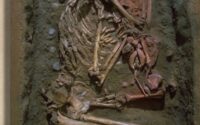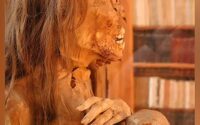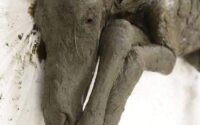Unveiling the Genetic Secrets of Mas d’en Boixos: A 7,500-Year-Old Puzzle of Kinship and Migration .bongbenh
Unveiling the Genetic Secrets of Mas d’en Boixos: A 7,500-Year-Old Puzzle of Kinship and Migration
Deep in the rugged landscapes of Catalonia, Spain, lies the archaeological treasure trove of Mas d’en Boixos, a site that has stood silently for over 7,500 years, guarding the secrets of ancient Iberian societies. Recent discoveries of ancient DNA from this prehistoric hub, spanning the Middle Neolithic to the Late Iron Age, have sent shockwaves through the scientific community, unraveling tales of family bonds, mysterious migrations, and a genetic tapestry that challenges everything we thought we knew about Europe’s ancient past. These findings, published in a groundbreaking study, paint a vivid picture of a world where kinship ties endured across millennia, where diverse ancestral streams converged, and where social structures hinted at practices that feel both familiar and alien. Prepare to dive into a story that will spark curiosity, ignite debates, and leave you questioning the roots of modern humanity.
A Time Capsule of Prehistoric Life
Mas d’en Boixos isn’t just another archaeological site—it’s a window into the soul of prehistoric Iberia. With over 450 structures, including dwellings, storage pits, and burial chambers, this site captures the evolution of human societies from the dawn of agriculture to the edge of the Iron Age. Nestled in Northeastern Iberia, it served as a cultural crossroads where people lived, worked, and buried their dead, leaving behind clues to their lives etched in bone and stone. But it’s the ancient DNA extracted from these remains that has archaeologists, geneticists, and history enthusiasts buzzing with excitement—and confusion.
The study, published in ScienceDirect in June 2025, analyzed genome-wide data from eight individuals and ten mitochondrial genomes from the Middle Neolithic (roughly 4500–3500 BCE) and Early Bronze Age (around 2200–1500 BCE), alongside three previously studied Iron Age individuals. What emerged was a story of family ties, genetic diversity, and migrations that defy simple explanations, raising more questions than answers about how ancient societies functioned and how their legacies shape us today.
Kinship Across Millennia: A Family Affair
One of the most captivating discoveries at Mas d’en Boixos is the evidence of deep familial connections preserved in the DNA of two Middle Neolithic individuals buried together. Genetic analysis revealed they were first-degree maternal relatives—possibly siblings or a mother and son. This finding is a rare glimpse into the emotional and social fabric of Neolithic life. Were these individuals buried together because of their close bond? Did their community honor family ties in death as they did in life? The intimacy of this shared burial sparks curiosity about the values of these ancient people. Did they prioritize kinship above all else, or was this a special case, a story lost to time?
The DNA of these relatives also revealed a complex ancestry, blending Western Hunter-Gatherer (WHG), Anatolian farmer, and a surprising trace of Magdalenian-associated heritage—a genetic signature linked to Ice Age populations from 19,000–15,000 years ago. This mix suggests that Neolithic Iberians were not just farmers who swept in from the Near East, as once thought, but a mosaic of ancient lineages that had been mingling for millennia. The presence of Magdalenian ancestry, in particular, is a head-scratcher. How did this ancient hunter-gatherer heritage persist so strongly in Iberia, long after farming transformed the continent? Could Mas d’en Boixos have been a refuge where older ways of life clung on, even as new cultures arrived?
A Bronze Age Family Network: Patrilocal or Patriarchal?
Fast forward to the Early Bronze Age, and the story gets even stranger. Six individuals buried in a collective hypogeum—a subterranean chamber—revealed a striking pattern. Genetic analysis showed that three of these individuals were third-degree relatives (think cousins or great-grandparents), and all the males shared the same Y-chromosome lineage. This points to a patrilocal society, where men stayed in their birth communities while women, with distinct mitochondrial lineages, likely married in from outside groups—a practice known as female exogamy. This discovery has sparked heated discussions online, with some calling it evidence of a patriarchal system and others arguing it reflects practical social alliances.
Imagine a Bronze Age village where brothers and cousins lived and died together, their wives coming from distant communities, bringing new stories, traditions, and perhaps even tensions. Why did women move while men stayed? Was this a deliberate strategy to forge alliances between groups, or a sign of male-dominated power structures? The collective burial itself raises questions: was this hypogeum a family vault, reserved for a prominent lineage? The fact that these individuals shared Steppe-related ancestry, with a subtle gradient increasing as you move south across Iberia, adds another layer of intrigue. Were these families part of a broader wave of migration, or were they locals who adopted new genetic and cultural influences?
Migration and Mixture: A Genetic Melting Pot
The genetic data from Mas d’en Boixos also reveals a dynamic story of migration and cultural exchange. The Middle Neolithic individuals carried a blend of ancestries that tied them to both local hunter-gatherers and incoming farmers from Anatolia, a pattern consistent with the Neolithic transition that swept across Europe around 5700 BCE. But the Bronze Age individuals showed something new: an influx of Steppe-related ancestry, likely brought by nomadic herders from the Pontic-Caspian steppe who migrated west around 2500 BCE. This genetic shift, seen across Europe, was less dramatic in Iberia than in central and northern regions, but its presence at Mas d’en Boixos suggests that even this remote corner of the continent was touched by far-reaching migrations.
What’s puzzling is the Mediterranean connection. The study hints at gene flow from Mediterranean populations, possibly linked to trade or cultural exchange along the coast. African ivory found at Iberian sites from the same period supports this idea, suggesting that Mas d’en Boixos was part of a broader network linking Iberia to North Africa and beyond. How did these ancient people, living in what we imagine as isolated villages, maintain such far-flung connections? Were they trading goods, ideas, or even marriage partners across the sea? The genetic evidence points to a cosmopolitan prehistoric world, but the details remain tantalizingly out of reach.
A Sophisticated Society: What the Structures Tell Us
Beyond the DNA, the physical remains of Mas d’en Boixos—over 450 structures—paint a picture of a sophisticated society. Dwellings, storage facilities, and burial chambers suggest a community that was organized, resourceful, and deeply connected to its rituals. The collective burial practices, especially in the Bronze Age, hint at a society where lineage and ancestry were central to identity. But the diversity of burial styles—individual graves in the Neolithic, collective hypogea in the Bronze Age—raises questions about shifting beliefs. Did the arrival of Steppe ancestry bring new burial customs, or were these changes homegrown?
The site’s longevity, spanning thousands of years, is another mystery. How did Mas d’en Boixos remain a focal point for so long? Was it a sacred place, a trading hub, or simply a fertile valley that sustained generations? Online forums are buzzing with speculation: some suggest it was a prehistoric “capital” of sorts, while others argue it was a melting pot where different groups met, clashed, and blended. The truth likely lies in a combination of these ideas, but the lack of written records leaves us piecing together the puzzle from bones and stones.
Rewriting the Story of Modern Europeans
Perhaps the most provocative aspect of the Mas d’en Boixos findings is what they tell us about the origins of modern European populations. The genetic blend seen in these ancient Iberians—hunter-gatherer, Anatolian farmer, Magdalenian, and later Steppe ancestry—forms the foundation of the genetic makeup of modern Iberians. Today, about 50% of Iberian ancestry comes from Neolithic farmers, 25% from hunter-gatherers, and 20% from Steppe herders, with traces of other influences, like North African ancestry, appearing later. Mas d’en Boixos shows that this mix was already taking shape thousands of years ago, with each wave of migration adding new threads to the genetic tapestry.
But this raises a contentious question: if Iberians were so genetically diverse, why do modern Basques, who share ancestry with these early farmers, show less Steppe influence? Some argue this points to cultural isolation, while others see it as evidence of resistance to outside influences. The debate is far from settled, and posts on X are ablaze with theories, from claims of a “lost Basque empire” to suggestions that Mas d’en Boixos was a genetic “safe haven” during turbulent times.

Why This Matters—and Why It’s Confusing
The discoveries at Mas d’en Boixos are more than just a scientific triumph; they’re a call to rethink our assumptions about the past. The evidence of family ties across millennia tugs at our hearts, reminding us that ancient people were not so different from us in their need for connection. Yet the complex genetic mixtures and hints of far-reaching migrations challenge the neat narratives we’ve built about prehistoric Europe. Was Iberia a melting pot or a battleground? Did Steppe herders impose their culture, or were they absorbed into local traditions? And what about those Mediterranean and North African connections—were they fleeting or transformative?
The online community is already grappling with these questions. On X, users like @TrueAncestry and @nrken19 have hailed the findings as a “game-changer” for understanding prehistoric migrations, while others express confusion over the persistence of hunter-gatherer ancestry in a region so far from the Ice Age refugia. Some even speculate about lost rituals or forgotten trade routes that could explain the Mediterranean links. The lack of definitive answers only fuels the intrigue, making Mas d’en Boixos a lightning rod for debate.
Join the Conversation
The genetic secrets of Mas d’en Boixos are a reminder that the past is never truly gone—it lives in our DNA, our landscapes, and the stories we tell. These findings invite us to ponder the lives of people who walked the earth thousands of years ago, their loves, their losses, and their journeys across continents and seas. But they also leave us with a delicious sense of confusion, as each answer spawns new questions. Were the Neolithic relatives buried together a family torn apart by tragedy, or a symbol of enduring unity? Did the Bronze Age patrilocal system reflect harmony or control? And how did a small Iberian valley become a crossroads of ancient worlds?
Join the discussion online and share your theories. Is Mas d’en Boixos evidence of a connected prehistoric world, or a unique outlier in Europe’s genetic history? Dive into the mystery, and let the ancient DNA of Iberia spark your curiosity about the roots of humanity.


